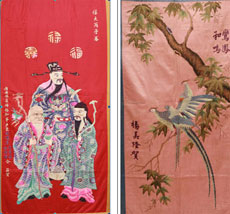Ancient works by the skilful artisans of Quat Dong embroidery village are on display at the Vietnamese History Museum in Hanoi.

The traditional craft has been in existence for thousands of years, first marked by embroidered letters on clothes and silk in the first century.
Books of history and legends talk of how Imperial Concubine Y Lan taught palace maids embroidery techniques in the 11th century of the Ly Dynasty.
But the craft did not really blossom until 600 years later when Le Cong Hanh returned home from his king’s envoy term in China.
Hanh who was a villager of Quat Dong, Thuong Tin District now on the outskirts of Hanoi brought back the embroidery craft of the Chinese and gave it to his neighbours and residents in surrounding communes. He was then honoured with the Ancestor of Quat Dong Embroidery.
Since then, using basic techniques, Vietnamese people have created many different styles of embroidery on all kinds of clothes of any size.
The beauty and quality of the village’s products grew in reputation and became a favourite of royal mandarins and dignitaries in Thang Long (Hanoi today).
Although the skills spread across the country, works by Quat Dong’s artisans are still most appreciated.
Due to a lack of publicity, it was needed to consider the art as a national heritage so museum officials decided to open an exhibition featuring typical works of the ancient embroiderers.
"The small exhibit which displays just 21 large artworks of embroidery cannot explain to people all about the national craft but they are the most excellent and beautiful examples," said Director of museum Pham Quoc Quan.
The exhibition includes four topics about flowers and birds, parallel sentences featuring ancient Han Chinese lettering, animals and people. All works, which date back to the early 19th century, are on display to the public for the first time.
The theme of flowers and birds occupies half of the collection featuring relationships and close ties between creatures in nature, such as pheasant and changing hibiscus, crane and pine tree and eagle and birch.
The skilful techniques of Quat Dong artists present in these works attracted people to their combinations of colour and natural positioning of the subject matter.
The embroidered parallel sentences in the Han Chinese characters were mostly used as objects of worship. In fact, it is not easy to write Han characters but Quat Dong villagers did their job so well that after they finished the characters were as beautiful as any handwriting.
There are four works about animals that were selected for display at the museum. Three pictures of chickens made viewers think of peaceful rural areas with the scene of a hen and its chicks searching the garden for food. Meanwhile the other took them to the superb rainforest where the tiger is the king.
Works on people seem to be the most difficult ones that required artisans to pay much attention to small and sophisticated details and would often be the responsibility of a senior.
At the show, visitors will have chance to look at a whole kit of embroidery tools including a tambour-frame with an incomplete work together with colourful threads and a set of needles.
Photos of the village, the ancestor’s portrait and biography, and embroidery activities of the residents are a part of the exhibition which is open until the end of January, 2010.